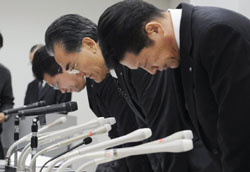
Lately, the public apology has been cheapened to the point of commodity. Hardly a month passes without a tearful, televised mea culpa from a politician or athlete. On the corporate front, the typical PR offering is more along the lines of “mistakes were made” – a masterful mouthful of nothingspeak. The banking industry’s contrition is epitomized by Goldman Sachs CEO Lloyd Blankfein’s stilted apology last November, followed by an orchestrated move to throw money at the problem. But, like the actions of a guilty husband trying to gift his way out of the doghouse, it smacks of insincerity.
Toyota’s recent response to its accelerating business and PR crisis reminded us that apology communications is in part shaped by culture. The “apology gap” between the U.S. and Japan is profiled in an entertaining New York Times column by Alina Tugend. Most telling, however, are the photos. (I couldn’t find the exact images online, but it’s worth looking at the hard copy of the paper if you have it.) The image of three U.S. bank CEOs – looking frustrated and combative at a government inquiry – is juxtaposed with a shot of Japan Airlines executives in a deep bow of contrition after filing for bankruptcy. The contrast couldn’t be more striking.

The piece echoes the observations of Bob Pickard, recently named CEO of Burson Marsteller’s Asia Pacific region. Pickard blogs that, after relocating to Asia from North America, “I increasingly found my own culture’s approach to apology callous and calculating; a tactic of last resort.” In Asia, perhaps, former Time Warner chief Gerald Levin’s mea culpa for “the worst deal of the century,” and his call for CEOs to take responsibility for poor decisions, wouldn’t have been quite so startling.
Yet, it’s not just culture. Most PR pros agree with me that it’s our legal system that gets in the way. In our litigious society, it’s hard to accept responsibility and pledge to change when it can be used against you in a class-action suit.
So, does Toyota have a strategic advantage over a typical U.S. company? In theory, yes. Its president took the first step by communicating regret over the massive product recall caused by a gas pedal problem. A U.S. spokesman went further by making it clear that Toyota takes responsibility for the problem rather than blaming it on a supplier.
Yet, the Toyota case also reveals when saying “I’m sorry” isn’t enough. When a risk to public health, safety or security has occurred, the infringing company must not only show contrition and accept responsibility. It must spell out how it will make things right, and convince stakeholders that it has done everything possible to eliminate the risk for the future.
Toyota will get there. The repair of its brand reputation will pick up speed when it announces its remedial plan with a full-court PR and advertising campaign, probably next week. That’s where Lloyd Blankfein and his colleagues might want to listen up. Until they’ve convinced us that the problem can’t happen again, their apology will be a little like a penny stock – cheap, not very credible, and lacking value over the long term.
MediaCurves.com just conducted a study among 601 Americans revealed that the majority (77%) reported that the apology by Jim Lentz, President of Toyota Motor Sales U.S.A. Inc., was sincere after viewing it. Toyota brand favorability was unaffected by the apology, with viewers rating the average favorability of the brand as 4.5 before and after viewing the apology.
More in-depth results can be seen at:
http://www.mediacurves.com/Apologies/J7732-ToyotaApology/Index.cfm
Thanks,
Ben
Toyota executives are currently testifying before Congress about the safety issues that have led to the recall of millions of vehicles. They insist that “We are confident that no problems exist with the electronic throttle control system in our vehicles.”
Thank you for your article. It’s good to read something that makes sense. I’m going to bookmark your site and come back to it.
I really appreciate this post. I’ve been looking all over for this!
Thank goodness I found it on Bing. You’ve made
my day! Thank you again